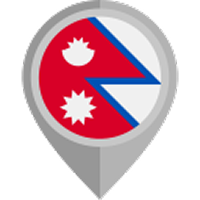Nepal vision | 30/05/2024
Are you looking to add an extra thrill to your Everest trekking journey? What if I tell you it's possible? Island Peak climbing is one of the most popular destinations among adventurers seeking an exhilarating challenge.
Perched at a majestic height of 6,189 meters in the eastern Himalayas of Nepal, Island Peak presents a breathtaking opportunity for high-altitude mountaineering. The journey is further enriched by the stunning vistas of the Sagarmatha National Park, a UNESCO World Heritage Site.
But when is the best time to embark on this thrilling ascent? Choosing the right season can make all the difference in ensuring a successful and enjoyable climb. Don't worry—we have covered all the information you require for the best time for island peak climbing, which is below.
Overview of the Season pattern in Island Peak
Island Peak is located in the eastern Himalayas of Nepal. The region is at a higher altitude so the weather can be a bit colder than in lower areas. The year can be broadly divided into four seasons: spring, summer, autumn, and winter. Each offers unique challenges and advantages for climbers.

Spring (March to May)
Spring is one of the most favorable times for climbing Island Peak. During this season, daytime temperatures range from 15°C (50°F) to 20°C (59°F), while nighttime temperatures can drop to between -10°C (14°F) and -5°C (23°F).
The weather is generally stable, with clear skies, mild temperatures, and relatively low precipitation, which ensures good visibility and pleasant trekking conditions. This period also offers a beautiful natural backdrop, with blooming rhododendrons (pink, white, and red) that add to the scenic beauty of the region.
Autumn (September to November)
Autumn is the crown jewel of seasons and is the perfect time to conquer Island Peak. The weather is a dream, with clear skies, excellent visibility, and temperatures ranging from 5°C (41°F) to 15°C (59°F) during the day and dropping to between -5°C (23°F) and -20°C (-4°F) at night.
This season offers stable and dry weather conditions, ideal for high-altitude climbing. The landscapes are a sight to behold, with the post-monsoon clarity unveiling breathtaking views of the surrounding peaks.
Summer (June to August)
Summer (June to August) brings in the monsoon season on Island Peak with increased rainfall and cloud cover. Daytime temperatures can reach up to 25°C (68°F), with nighttime temperatures ranging from 5°C (41°F) to 10°C (50°F). This season is marked by frequent showers and overcast skies, from drizzles to heavy downpours.
The trails become wet and slippery, making climbing conditions more challenging. Rain and clouds often reduce visibility, increasing the risk of avalanches and landslides.
Summer is a possible time to climb the island peak, but you may not have a chance to see the views of the mountain ranges you have desired.
Winter (December to February)
Winter is the coldest season on Island Peak, with daytime temperatures typically below freezing, around -5°C (23°F) to -10°C (14°F), and nighttime temperatures dropping below -20°C (-4°F). The winter months bring harsh weather conditions, including heavy snowfall and strong winds.
The days are shorter, and the extreme cold makes climbing more strenuous and challenging. The heavy snow and ice increase the technical difficulty of the climb, posing a greater risk even for experienced climbers.
Due to these extreme conditions, winter is not recommended for beginners and is generally less popular for climbing Island Peak.

Overview of the Island Peak
Island Peak is situated in the Sagarmatha National Park, nestled in the trail of the Everest Base Camp. Its striking appearance, resembling an island in between a sea of ice, earned it the name "Island Peak" in 1953 when viewed from Dingboche.
The terrain presents arduous obstacles to climbers, including glacier crossings, steep snow and ice slopes, and an exposed summit ridge. These technical challenges demand skill, endurance, and careful navigation, making Island Peak a thrilling yet demanding ascent.
Island Peak holds a special allure for mountaineers and trekkers, serving as an ideal training ground for those aspiring to conquer higher Himalayan peaks. Its accessibility, with its technical challenges, offers climbers a taste of high-altitude mountaineering without the extreme risks associated with taller peaks.
Moreover, the climb rewards adventurers with awe-inspiring vistas of the surrounding Himalayan peaks, including the iconic Mount Everest. For many, summiting Island Peak represents an achievement and stepping stone to even greater mountaineering endeavors.
Tips to Climb Island Peak
- Acclimatize Adequately: Allow sufficient time for acclimatization to the high altitude by following a gradual ascent schedule, taking rest days, and staying hydrated to reduce the risk of altitude sickness.
- Train and Prepare Physically: Prioritize physical fitness training, including cardiovascular exercises, strength training, and flexibility exercises to build endurance, strength, and resilience for the challenging climb.
- Hone Technical Skills: Familiarize yourself with essential mountaineering techniques such as glacier travel, ice axe use, crampon techniques, and rope handling to navigate the technical terrain safely and efficiently.
- Pack Appropriately: Pack essential gear and equipment including proper clothing layers, mountaineering boots, harness, helmet, ice axe, crampons, ropes, and safety gear to ensure comfort, safety, and preparedness for varying weather and terrain conditions.
- Follow Safety Protocols: Prioritize safety at all times by staying roped up when traversing glaciers, using proper climbing techniques, adhering to guide instructions
To wrap up, climbing Island Peak is an achievable adventure, even for beginners. With proper preparation and the guidance of experienced climbers, aspiring mountaineers can conquer this majestic peak while soaking in the stunning vistas of the Himalayas. For those ready to take on the challenge, Nepal Vision Treks offers the support and expertise needed to make your Island Peak expedition a safe and unforgettable experience.
FAQS









